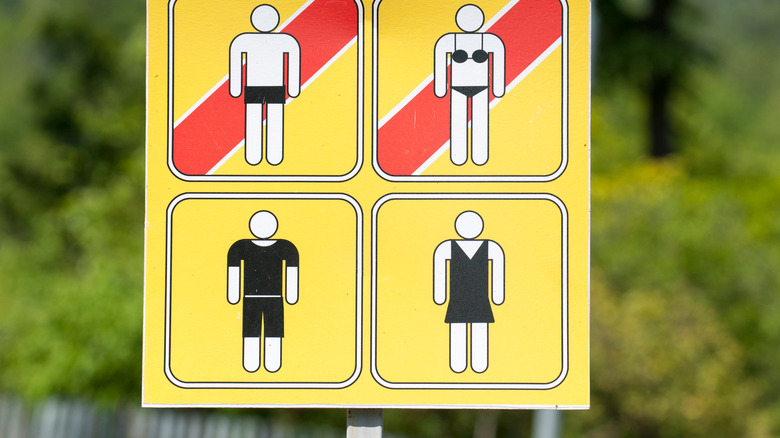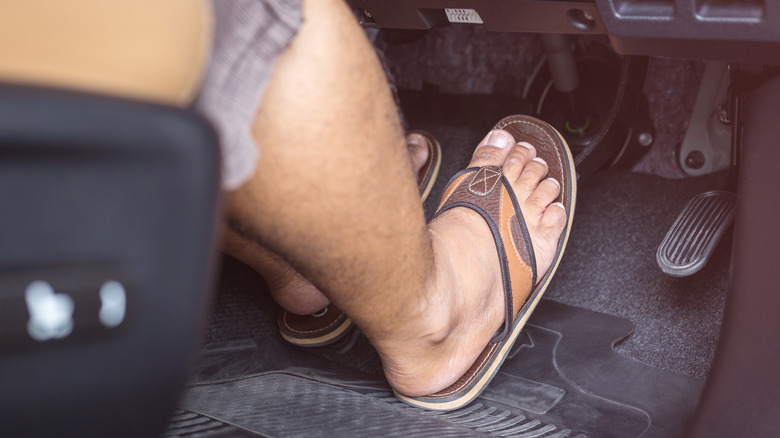Why Tourists Need To Be Cautious Of The Clothing They Pack On A Trip To Europe
Packing for a trip is all about planning, organization, and adaptability. From choosing the right fabrics to ensure you always look your best while on vacation to maximizing carry-on space and minimizing over-packing — you always want to make sure you avoid making packing mistakes that can eventually turn any holiday into a logistical nightmare.
These outfit oversights and packing shouldn't-do's go beyond forgetting to bring a jacket or deciding to pack a brand-new pair of shoes that blister your feet (ouch!). In fact, depending on where you go and what you do, making a clothing mistake could land you in some pretty bad trouble with local officials — and, sometimes, even incur a hefty fine that could ruin the rest of your trip.
From walking around in nothing but a bathing suit to wearing heels at historical sites, there are certain destinations across Europe that take their dress codes very seriously.
Cover yourself up in Italy
Sure, Italy might be known as one of the most fashionable destinations in the world. However, travelers looking to go beyond the shops should be aware that certain historic and cultural sites require guests to leave the trends at home and follow a strict, relatively conservative dress code instead.
For example, if you're planning to visit popular tourist spots like the Vatican, the Pantheon, or the Museum of the Dead — along with churches and other sacred places — it's important to read up on the rules to avoid getting caught off guard at the door. Specifically, most of these sites require that you cover up your knees and shoulders (a cardigan or shawl works perfectly during the hot summer months), not wear crop tops or anything with revealing cut-outs, and switch up the low-cut top for a higher neckline that covers more skin.
Similarly, destinations outside of cities like Rome and Milan are also enforcing their own rules in order to crack down on inappropriate attire. For example, Sorrento recently announced that it would start fining visitors up to $546 for walking around town in a bathing suit. Meanwhile, Praia a Mare — in the southern region of Calabria — has gone as far as banning people from walking around barefoot.
Don't walk around in swimwear in Croatia
Similar to Italy, Croatian officials and authorities have been playing their part in ensuring that visitors follow basic etiquette and dress codes — especially when it comes to when and where to wear the right thing. In fact, both Split and Dubrovnik are cracking down on shirtless and bikini-clad tourists walking around cultural and historic city centers. Slapping them with fines of up to $160 for disobeying the public dress code, local officials hope this will dissuade tourists from flouting local norms.
Let's put it this way: You wouldn't want to run into a rowdy group of half-naked tourists on your way to a sacred site or formal venue, right? Well, neither do Croatians, who already have to deal with crowds and noise — especially during the summer months.
In addition to this, clothes and accessories that allude to drugs and drug use are also banned from most town centers in Croatia — and can result in a fine or, worse, jail time for anyone seen wearing them.
Kick off the high heels in Greece
Dreaming of wearing your best dress with the perfect pair of high heels while strolling around Greece's most beautiful sites? Think again. Since 2009, Greek officials have enforced a strict "no heels allowed" policy at popular tourist destinations, like the Parthenon and Acropolis, in order to preserve the archeological sites' integrity and structure.
Since heels tend to be quite sharp and potentially damaging, experts decided that the best way to protect these thousand-year-old monuments was to completely ban visitors from wearing any type of pointy, narrow, or too-harsh footwear that could cause unnecessary wear and tear to the surface. Instead of trying to make a fashion statement, simply pack a pair of walking shoes, and you should be good to go.
Along with this, certain churches and monasteries in Greece also require that visitors dress modestly — as in, nothing cropped, low-cut, or revealing — in order to respect the sanctity and traditions. In some cases, wraps are available for rent at the entrance of certain sites.
Slip on some speedos in France
Men, this one's for you! Most popular French beaches are all about kicking back and letting loose: think riding world-class waves, playing volleyball surrounded by scenic views, and even catching some rays where the sun don't shine (if you know what we mean...).
However, if you're planning on hitting up a public pool during your time in the country, it's best that you come prepared to show off a little more skin than you're probably used to. Specifically, that means packing a Speedo alongside your sunglasses and sunscreen.
Since 1903, France has strongly encouraged that all men and boys who visit public pools wear the tight-fitting swimwear as opposed to loose trunks or board shorts. The reason? Speedos are more hygienic than their baggy counterparts. Speaking to The Daily Star in 2022, Emmanuel Dormois — a head pool attendant in Paris — told the outlet that, while swimming shorts can be worn throughout the day — and accumulate dirt, grime, and sand in the process — speedos are only worn while swimming, which means there's less of a chance that they'll bring something into the pool water.
Ditch the flip-flops in Spain
If you're planning on choosing a rental car during your vacation to Spain, it's important to keep in mind that certain regulations might mean you can't just wear anything behind the wheel — especially when it comes to your footwear of choice.
Specifically, local authorities in Spain have been working toward keeping their roads and drivers safer by dissuading people from wearing flip-flops while they drive, as this could compromise control of the vehicle and increase the risk of accidents.
Although wearing flip-flops while driving isn't technically illegal, your shoe choice could still lead to penalties. According to Spain's Department of Traffic (DGT), driving barefoot or with flip-flops could incur a fine of up to $215 if the driver commits an infraction as a result of impaired driving abilities. Meanwhile, driving shirtless — which goes against the local rule that drivers always need to ensure their safety because if there's an accident, the seat belt can hurt a shirtless driver — could also result in a fine of roughly $107.





